Trucking companies and owner-operators have long been on a relentless quest to save money. If they can stretch that dollar just a little further, it can mean bringing a little more money. One of the best ways to pad a trucker’s bottom line is through getting them to drive an advanced semi, and in 1959, General Motors built what was, at the time, America’s most advanced semi-tractor. The GMC DLR 8000 and DFR 8000, nicknamed the ‘Cracker Box’ for its shape, were miles ahead of the competition and promised to fill the pockets of truckers, but did so at the expense of practically everything but hauling capability.
Most of the semis that I have written about thus far were built as solutions to high fuel prices and gas crunches. The engineers of those trucks were obsessed with gaining fuel efficiency through aerodynamics. But before the 1970s and its infamous oil crises, aero wasn’t as much of a concern. Instead, truckers were more concerned with maximizing the size of their loads within the restrictions set by state governments.
In the decades preceding the formation of national standards of tractor-trailer length and weight in the 1980s, the states set their own rules. In 1913, at least four states had truck weight limits. In those early days of regulation, a truck driving through Maine couldn’t weigh more than 18,000 pounds, while a truck in Massachusetts was allotted 28,000 pounds. Pennsylvania’s and Washington’s limits were 24,000 pounds. These early weight limits existed because heavy trucks tore up the rudimentary roads of the era.

The U.S. Department of Transportation notes that it wasn’t long after those early days when states began imposing limits on truck lengths, widths, and heights. By 1929, most states had some sort of regulation limiting the size of a truck. Length limits varied wildly, but at least most states agreed on 96 inches as a maximum width. By 1933, every U.S. state had limited truck size and weight in some way.
These length limits were imposed on the whole tractor-trailer and were sometimes ridiculously harsh. As Curbside Classic notes, the railroad lobby once successfully convinced Illinois to limit the total length of a tractor and trailer to just 35 feet. Allegedly, the idea was that if trucks were too short to be an efficient method to move cargo, more freight could be shipped by rail. This would remain the law in Illinois until the federal government stepped in with standardized trailer lengths.
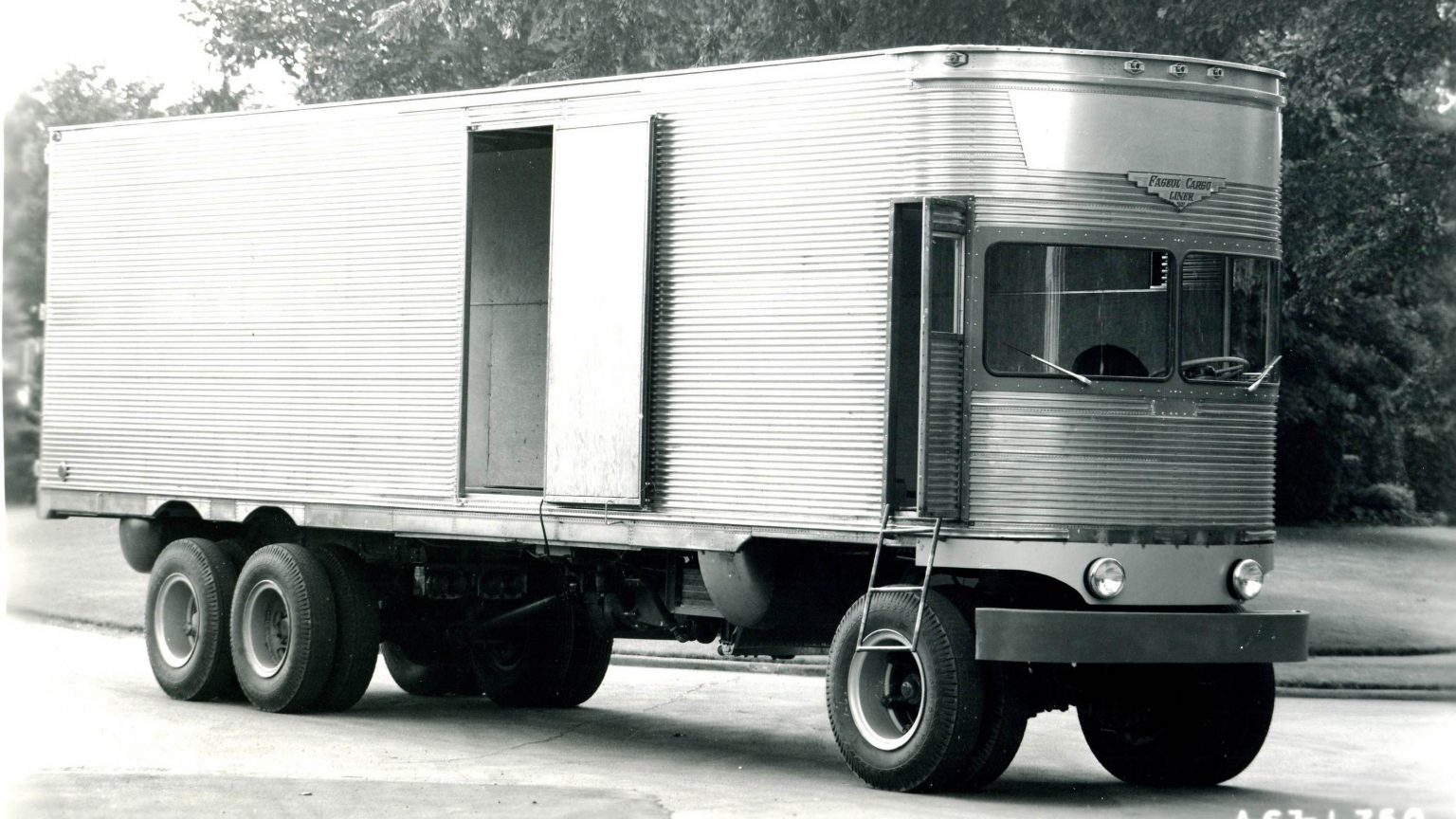
All of this meant that if you wanted to maximize your load and therefore maximize your profit, you had to get clever. This is why the cabover semi ruled American roads from the earliest days of trucking until just after the relaxation of length limits in the 1980s. Cabover semis were shorter than conventional semis, which meant that truckers could carry larger loads. This is why we’ve seen wild builds like a car carrier truck that placed cars between the cab and the engine, and a truck that tried to maximize space by being all trailer.
In the 1950s, General Motors saw length and weight restrictions as an opportunity to build the ultimate truck. It would build a truck that weighed dramatically less than the competition and be so small that truckers could carry a greater payload with a GMC truck than with the competition.

How GM Used To Build Trucks
America’s automakers no longer participate in the Class 8 semi market, but for several decades, General Motors, Ford, and Chrysler didn’t just sell big rigs – they tried to beat the likes of Peterbilt, Freightliner, and Kenworth at their own game. Truck builders constantly one-upped each other in bids to win truckers over. To understand how GMC ended up with its iconic ‘Cracker Box,’ let’s take a look at what came before.

The immediate predecessor to the Cracker Box is the truck affectionately known as the ‘Cannonball.’ As Hemmings writes, this generation of GMC Class 8 tractors dates back to 1947, when GMC introduced new designs after World War II. These cabover trucks went by official designations like HDF for diesels and 620 for gasoline trucks and had designs similar to GM’s lighter-duty Advance Design trucks. According to the American Truck Historical Society, the most famous of the line was the DW 950:
Part of GMC’s top-tier lineup from 1947 through 1954, the 950 series came in two distinct forms: the DW 950, a conventional long-hood tandem-axle tractor, and the DFW 950, its forward-control (cab-over-engine) counterpart. Both were designed to move serious freight, but each played to its strengths—the DW for long, open highway runs, and the DFW for tight quarters, steep grades, and urban maneuvering.

Regardless of configuration, the heart of these trucks was the Detroit Diesel 6-71, a two-stroke inline-six that quickly became one of the most iconic engines in American trucking. Introduced in 1938 and produced through 1995, the 6-71 earned nicknames like Screaming Jimmy, Driptroit, and simply the Detroit, thanks to its distinct sound and reputation for durability (and the occasional oil leak).
In a DW 950, the 6-71 typically paired with a 5-speed main and 4-speed auxiliary transmission ideal for long-haul operators running heavy loads across states or regions. The DFW 950, meanwhile, could be outfitted with a 10-speed constant-mesh transmission for mountain climbs and frequent shifting, often seen pulling doubles in fleet service.
According to former GMC engineer and GMC historian Donald E. Meyer, GM’s next evolution of this generation of truck came in 1955 with the DF 860. GMC touted these trucks as being able to haul more loads for cheaper than ever before. Much of that was due to what was under the cab, a 7.0-liter Detroit Diesel 6-71SE straight-six diesel that delivered 190 HP gross (173 HP net) and 508 lb-ft of torque. GMC bragged that its engine punched out this power at an easy 2,000 RPM and without supercharging.

One of the truck’s highlight features was its non-tilting steel cab with a special way to service the engine. Since the cab couldn’t tilt, GMC gave the truck an interior with fold-up seats and flip-up floorboards. This next part gets a little fuzzy, but in 1958, this generation of truck became famous for its appearance in the TV series ‘Cannonball.’ That’s where the truck’s nickname comes from. Donald E. Meyer says that the DF 860 is the Cannonball, while the American Truck Historical Society says the Cannonball was the 950. So far as I can tell, it seems a lot of folks just consider the whole generation to be ‘Cannonball’ trucks.
But I suppose that isn’t super relevant because it’s what came next that we’re here for.
The ‘Cracker Box’
The Cannonball trucks were followed up by the Cracker Box trucks, officially the DLR 8000 and DFR 8000 cabovers. These big rigs came from that fascinating time in the late 1950s and early 1960s when General Motors punched out moonshot projects worthy of admiration.

Curbside Classic rightfully points out that these Class 8 tractors were surrounded by greats like the Chevrolet Corvair, the Oldsmobile Jetfire, and the Pontiac Tempest, plus engineering achievements like Buick’s aluminum V8, the short-lived ‘rope drive’ system for the Tempest, and the Turboglide three-speed automatic. Don’t forget other icons like the Corvette Sting Ray and the Chevrolet Nova. General Motors embraced the new Jet Age in stride, optimism, and innovation, and its heavy trucks did not miss out.
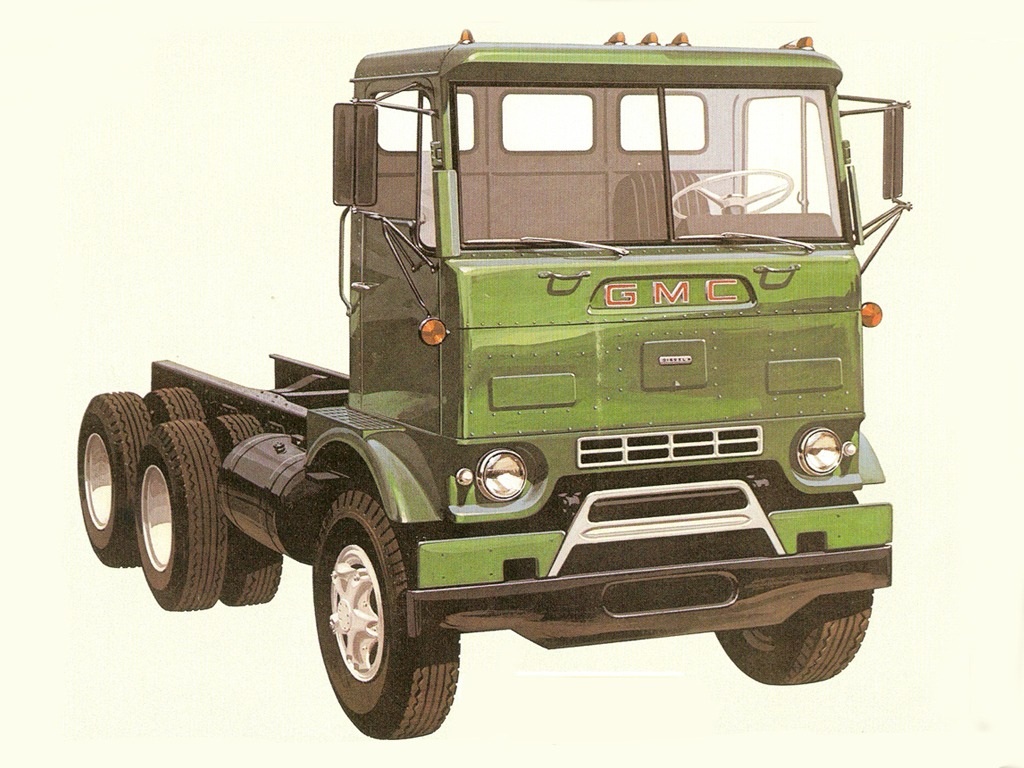
For 1960 DLR 8000 and DFR 8000, which launched in 1959, GMC decided to go all-in on increasing the profits of the driver at all costs. To facilitate this, GMC focused on lowering weight and shortening length. As I said earlier, there were strict length and weight limits on trucks back then, and the best way to increase loads was to minimize the truck.
One of the highlights of the GMC DLR 8000 and DFR 8000 was its cab. The truck’s BBC, or bumper to back of cab, was just 48 inches. That’s a shockingly small cab, and its comically small size resulted in a visual that resembled a cracker box tilted up onto its side. Amazingly, GMC even sold a sleeper version of this cab, but it came with a puny 21-inch wide bed, so I could not imagine that driving this rig long haul was anything resembling comfortable. However, GMC claimed to have done testing and said that even the tallest drivers had no problems fitting into the cab.

But making the cab small wasn’t the only part of the recipe. Unlike its predecessor, the cab eschewed steel for aluminum, which shaved off tons of weight to become a svelte 696 pounds. Trimmings, like fenders and the grille, were fiberglass. This cab was now of the tilt variety, as well. GMC touted further weight savings with its new Detroit Diesel 6V-71, which weighed 200 pounds less than the previous generation, and the new fabricated frame, which shaved an additional 300 pounds from the Cannonballs. Apparently, the frame alone, which was built in a welded ‘I’ beam configuration, was half the weight of the old Cannonball frame.
According to the Commercial Car Journal, which broke the news of the new truck series in 1958, the trucks had a curb weight of 9,987 pounds with 100 gallons of diesel fuel.

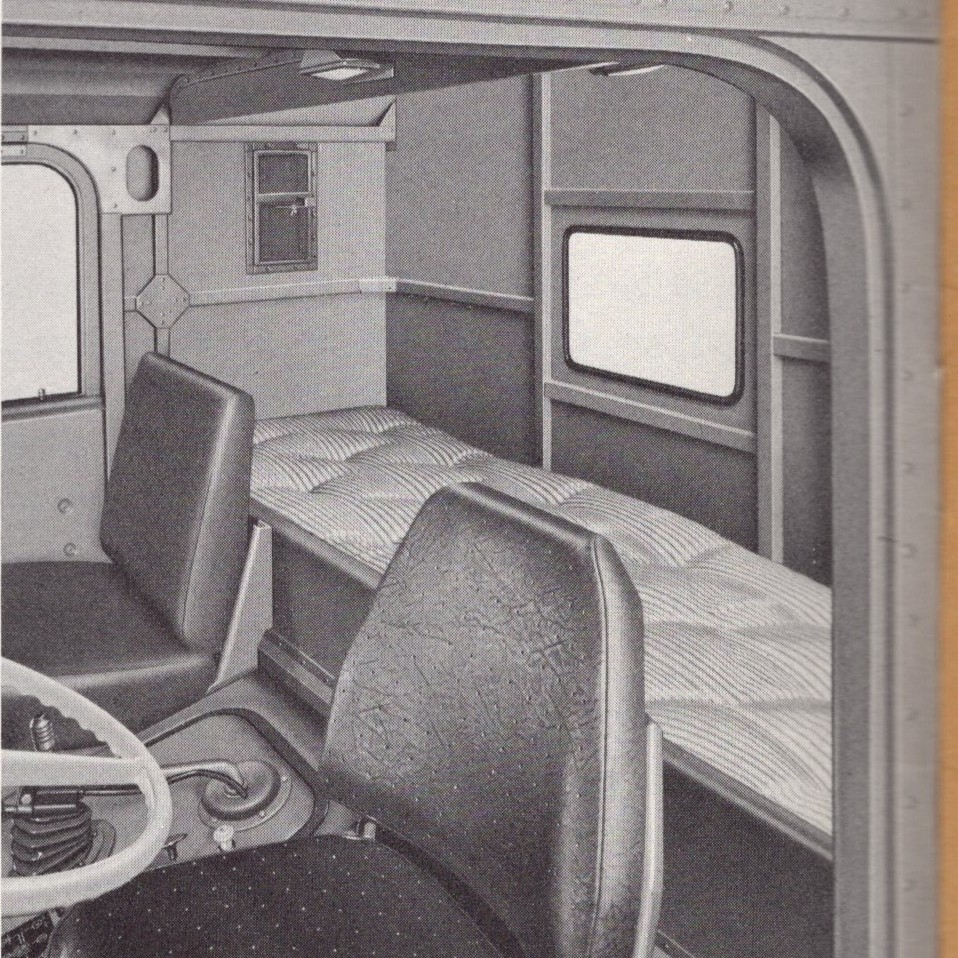
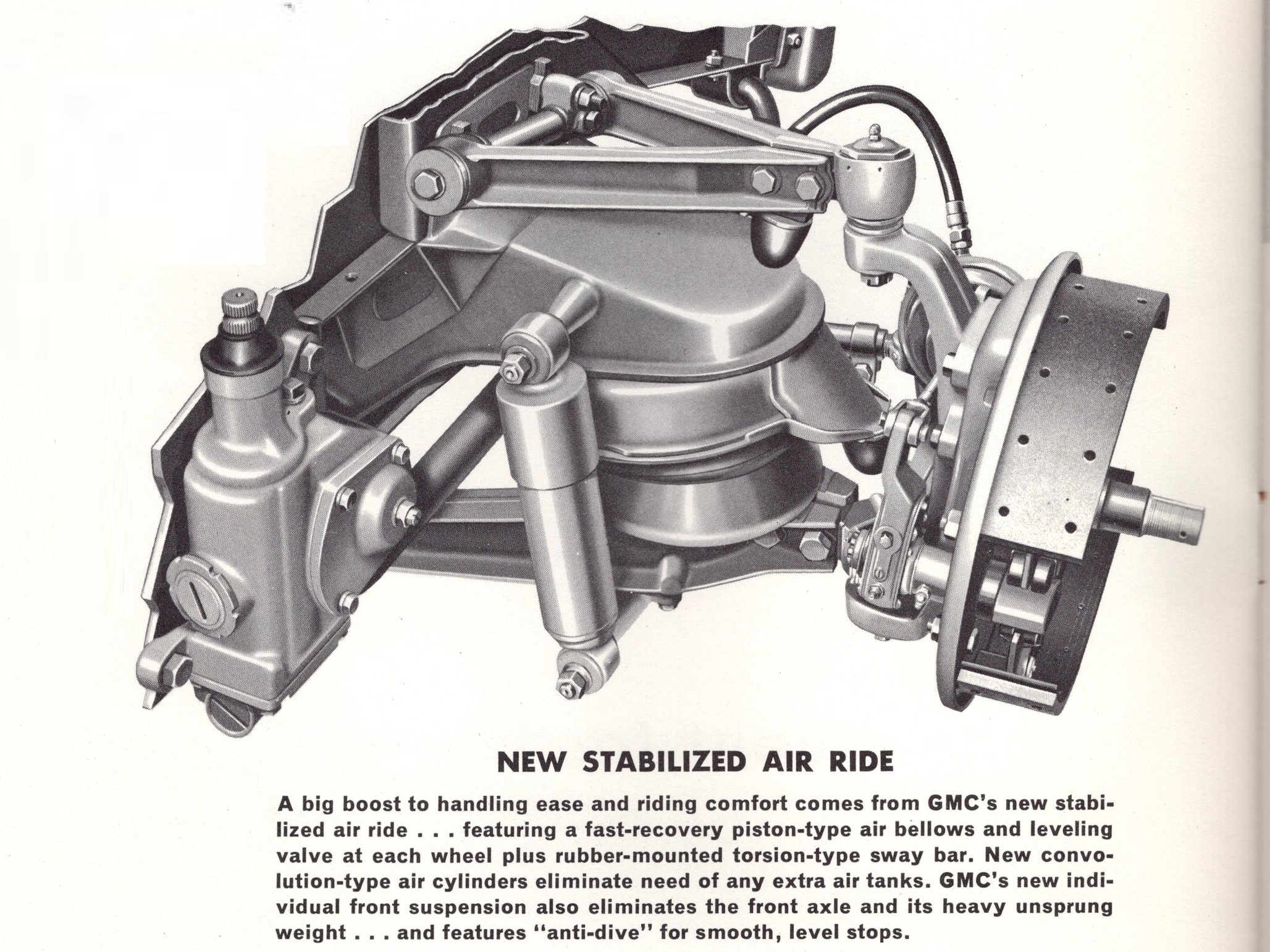
In case you were wondering, here was the difference between the DLR 8000 and the DFR 8000, from Fleet Owner:
Companion model to the DFR-8000 is the DLR-8000 with front axle set back 50 in. from front bumper. The DFR-8000 has a front axle position of 28 in. from the front bumper.
Despite the weight savings, GMC says the new frames, which were made out of SAE 950 steel, were much stronger than the Cannonballs. Other goodies in the DLR 8000 and DFR 8000 trucks included an optional air suspension, an independent short arm long arm suspension with ball joints, and a standard 108-inch wheelbase, with an optional 130-inch wheelbase. Add it all up, and GMC says that the new trucks could carry 2,000 pounds more (76,000 pounds total for combinations) than their predecessors and between 699 pounds and 2,097 pounds more than the conventional models. That, GMC says, was supposed to add $2,000 in profit ($22,114 in 2025) a year for a trucking company or an owner-operator.
Under The Power Barn
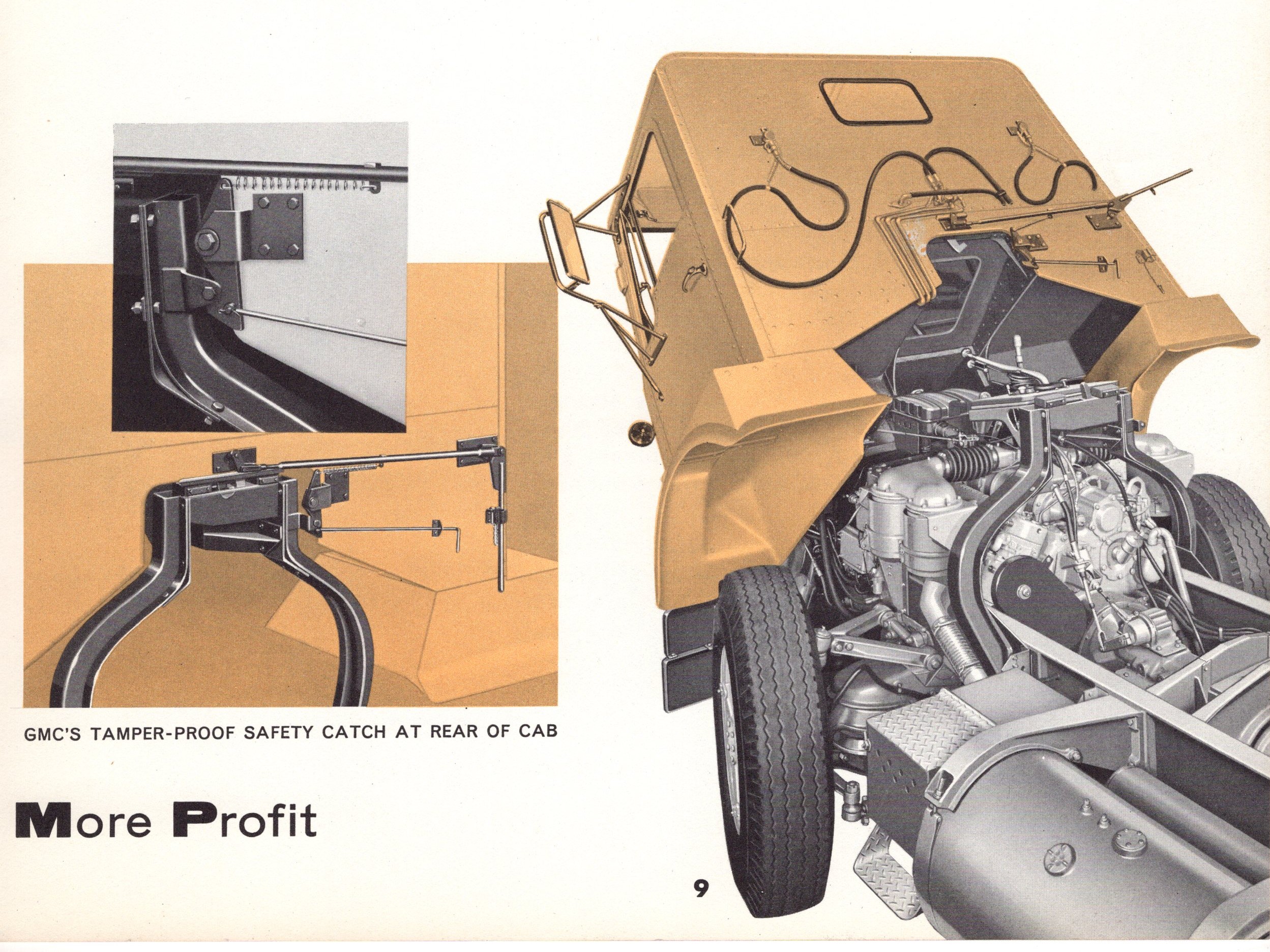
The Cracker Box trucks also got a wide array of healthy power options. The aforementioned 6V-71 was a 7.0-liter two-cycle V6 diesel with 189 gross HP on tap at 1,800 RPM with an optional upgrade to 210 HP. Available power also included the 9.3-liter Detroit Diesel 8V-71 V8 diesel, and Caterpillar and Cummins engines would be available later on. If you ordered one of these rigs with a standard drivetrain, you got a five-speed Spicer manual transmission with synchromesh and a two-speed Eaton rear axle.
The coolest engine, at least from a car enthusiast perspective, was the 702-cubic-inch V12. Our Thomas Hundal has written about that engine before:
See, in the late 1950s, diesel commercial engines were gaining market share and GMC wanted to fight back with gasoline power. The answer was simple: Take two existing engines and sort-of glue them together to create something borderline obscene. After some thought, engineers decided on merging wo 351 cubic-inch V6 engines together to create a 11.5-liter V12. Granted, the V12 does sport its own unique block, crankshaft, and camshaft, but the cylinder heads are exactly the same as on the V6. Yes, this means the Twin-Six has four cylinder heads and four exhaust manifolds, along with the expected two distributors.
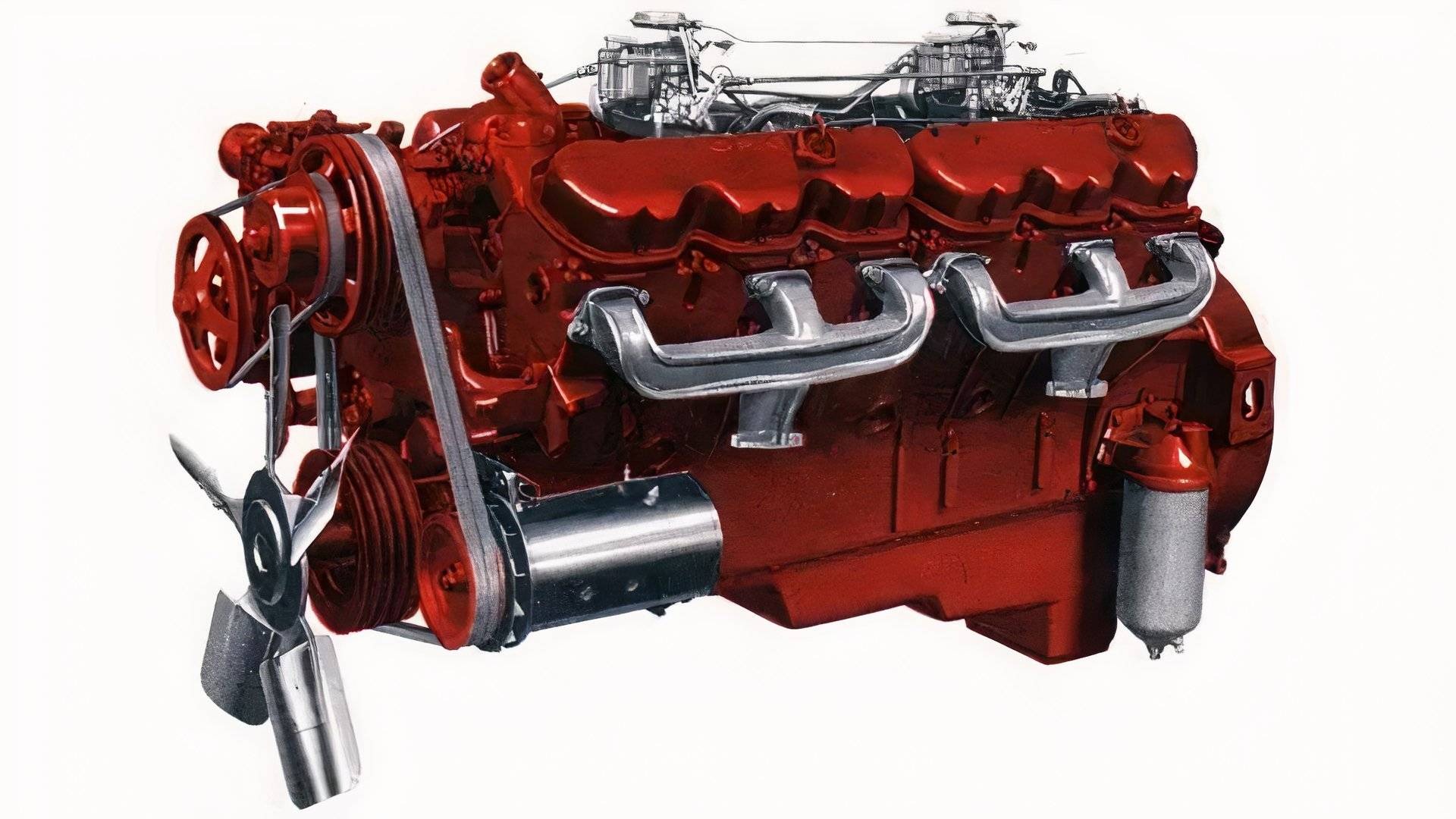
Oh, but the insanity doesn’t stop there. The crankshaft alone weighs 180 pounds, the wristpins for the pistons measure more than an inch in diameter, the oiling system demands 16 quarts of black gold, the water pump pushed two gallons a second, three thermostats helped keep this thing at operating temperature, and the entire engine weighs nearly 1,500 pounds. Engine length? Try 53 inches long.
All this monstrous size added up to — wait for it — 275 horsepower at launch. That doesn’t sound impressive, but peak horsepower hit at 2,400 rpm. Peak torque was a burly 630 lb.-ft. from 1,600 to 1,800 rpm, an astonishing figure for a gasoline-powered commercial engine from the 1960s. GMC advertised this engine for use in both commercial vehicle and stationary applications, claiming it would run up to 200,000 miles between major overhauls in a period advert. Another claim? That the Twin Six was the cheapest way possible to pump 1,500 gallons of water per minute. Hello, fire department?
A Spartan Hard Worker

Heavy Duty Trucking Magazine notes that the Cracker Box was the poster child of semi-tractor development of the era. It was ugly, spartan, and uncomfortable – but it had no problem pulling absolutely gargantuan loads within the strict legal requirements of the day. Apparently, they were also easy to repair and dependable. If you didn’t care at all about comfort, apparently, the Cracker Box did as it said on the tin.
While I could not find a period review, Heavy Duty Trucking‘s Senior Editor Jim Park had firsthand experience with these trucks when they were new, from HDT:
These trucks were not fun to drive. I first ran into one in 1978 or ’79 as my career was just getting started. Being the junior man at this particular company, I had my choice of the trucks parked in the back row of the lot. I picked a 6×2 axle model, with an air-lift pusher axle. No AC, no power steering, and all the noise and heat you could handle coming up through the floor.

The truck had a 238-hp 6-cylinder two-stroke Detroit 6V-71 diesel engine. Being a two-cycle engine, it had one unique attribute: When backing under a trailer to hook up, you had to hit it pretty hard sometimes to ensure you got under it on the first shot. I learned the hard way that if the trailer pushed the tractor out as you were trying to pick it up, it would spin the engine backwards, and the darned thing kept running — but backwards, sucking air in through the exhaust stack and exhausting through the air cleaner. It was pretty strange putting the transmission in first gear and taking off in the wrong direction!
It’s not known exactly how many of these trucks GMC sold between the model’s launch in 1959 and the end of sales in 1968. Heavy Duty Trucking notes that while the Cracker Box might have been America’s most advanced truck at its launch, the rest of the truck manufacturers would eventually catch up, and the Cracker Box would lose its edge.

Ultimately, in 1969, GMC would replace the Cracker Box trucks with the GMC Astro, which would also get a Chevrolet version with the Titan. These trucks traded the extremes of the DLR 8000 and DFR 8000 for far more interior room, better comfort, slightly better aerodynamics, improved visibility, and more.
What’s interesting is that, despite once being America’s most advanced truck, the Cracker Box is largely forgotten today. If you find one for sale on Facebook Marketplace, don’t be surprised if it’s less than $10,000 or even less than $5,000. So, it doesn’t seem like there are people rushing to snatch these trucks up for collections like they would a Dodge Bighorn or some other trucking icon. But hey, that’s not bad if you’re like me and you’re crazy enough to collect commercial vehicles!
Still, it shouldn’t be discounted what GMC achieved. When faced with tough regulations, it found a way to give truckers a ride that hauled more loads, and did so with an obsession for minimizing to the maximum. It’s just another example of that ambitious spirit that seemed to fuel General Motors back in those days.
Top graphic images: GMC; Nabisco

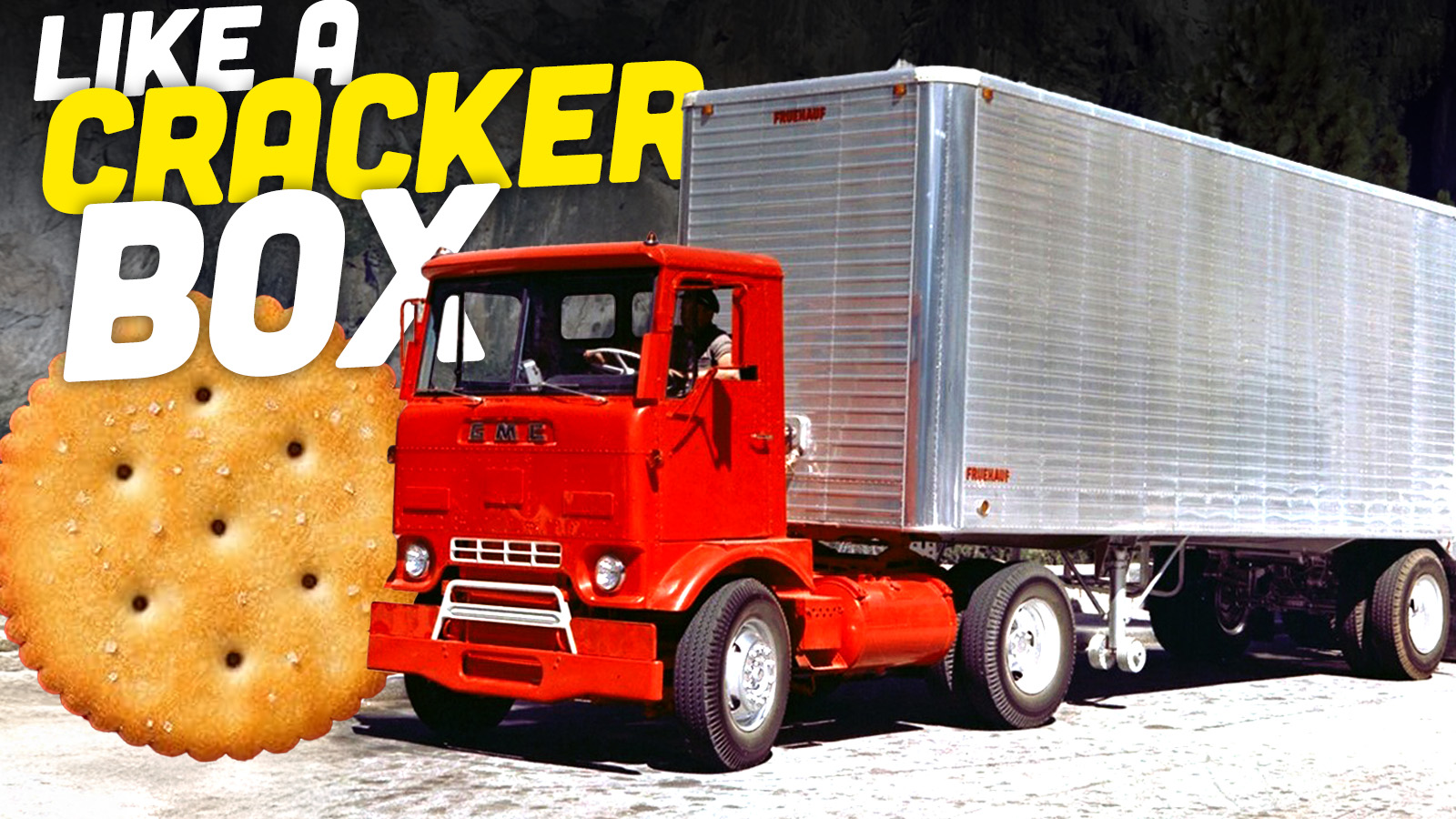






It looks strange to the eye.
I think I might go for the Jeeper Creepers model.
“Cracker Box” Ha ha ha ha ha…I love this headline…they sure look like it too! Also, I can’t stop laughing when I see that “trailer+semi in one” picture…it looks so goofy! Ha ha
(That previous article about them was good too) Also, that V-12 sounds awesome (despite the 275 HP)
I dream of a Torch article about some yet undiscovered tall strange VW T2 FWD COE truck, you could just slab on to anything with wheels, like the EA489/Hormiga only taken to the extreme, from some strange place in South America, Paraguay maybe?
Love those compact 20th designs, from before crumple zones were really a thing.
Well, sideways maybe
https://www.theautopian.com/this-incredibly-obscure-air-cooled-vw-powered-truck-does-something-only-one-other-air-cooled-vw-ever-did/
Several manufacturers made similarly short “suicide cabs” UPS used Mack F series day cabs, and also some cement mixers. There’s an International Transtar and a Freightliner near me that are both hay haulers.
Hay haulers are the Cambrian exosion of vehicle evolution.
Does this include the long wheelbase tractor with a flatbed behind the cab, to squeeze a few more bales on the truck?
Based on my bus driving days, if a Detroit isn’t leaking, you had better be damned sure the thing actually has oil in it. They leaked brand new. Very British of them.
Good engines overall though. And nothing sounds better wound up than a Screamin’ Jimmy. Though preferably in the back of a bus about 35 feet behind you. I’d say I can’t imagine how loud a Crackerbox is in the cab, but I have watched enough Youtube videos to have a pretty good idea. Are there any old truck driver’s with working hearing?
Check out what Cole’s Express out of Maine did with a few: https://www.hemmings.com/stories/crackerbox-palace-1964-gmc-dfx7009/
Their trucks had been hauling potatoes south and returning without full loads of cargo, and the addition of a 3,300-gallon tank behind the short cab (supported by a tandem steer axle) let them haul oil on their return journeys.
I’ve seen that rig in the Cole’s Museum in Bangor. Super cool! Definitely worth a stop if you are into old trucks.
Wow, SLA front suspension in a 1950s semi. Although it looks like it is to drop the engine really low in the frame rails without a beam suspension getting in the way, instead of for comfort or handing.
Great write up, Mercedes. Immediately reminded me of “Semi Crazy” by Junior Brown:
“They say I gotta be half crazy to be doing what I do.
I’m a slap happy, gear jamming coffee drinking, truck driving fool
I may have a little shimmy in this cracker box Jimmie
But I ain’t never cracked up yet.
The more I try to make a buck in this beat up truck
The more semi crazy I get”
Junior Brown is a skilled guitarist and his version of Freeborn Man on YouTube is some amazing showmanship.
So GM owned the Titan name at one point? Did they just let that lapse or sell it to Nissan?
Probably let it lapse after its discontinued use in the early 80s
Very interesting. And it proves the old saying, “First to arrive at an accident.” That’s a scary looking box.
These look as comfortable to drive as a Chevy LUV.
Mack had a similar cabover Called the Mack MB
The MB, and a similar looking White cabover were primarily medium duty straight trucks plus some urban delivery tractors. Mack ultimately replaced most MB applications with the Midliner, which was made by Renault.
Also had a daycab in the model f series, FedUps and midnight express used em
The Astro (class 8) was way ahead of its time. gm was great in those days. Now: a rubbish company. The 6.2, the HD 10 speed, 10,000lb hummer, ignition keys that kill you, a 6th place equinox, 5 th place malibu, Blazer rated as the worst car in 10 years (per CR) and on and on……
I don’t trust CR at all.
EPA and CAFE requirements have also played a role.
And let’s be honest: MOST manufacturers are now producing low quality vehicles as well (Ford, RAM, Toyota are also NOT what they used to be).
I’d never heard of these. Neat stuff!
Any man (and it was pretty much ONLY men) who drove a semi-truck before ~1990 absolutely qualifies as a Tough Old Bastard™, and especially so for long-haul drivers. It was not a career for the weak.
From all I’ve read it’s still a miserable job, albeit for different reasons.
My dad had an IH (road) tractor with an 8V-71 and a 4×4 transmission in the early 70s. When he sold it and bought a Kenworth with a 350 Cummins and a 13-speed Fuller RoadRanger, he thought he had died and gone to Heaven. (And also spent a lengthy period in Hell, paying it off.)
Awesome article! I absolutely love this type of content, it’s one of the big reasons I come here.
I remember seeing trucks like this in reruns of 70’s tv shows I watched as a little kid, I was always fascinated with them.
Silly me- based on the photo, at first I thought the cracker box styling was the trailer box behind the cab and not the cab itself.
Yep. All I could see in my mind was the metal tin my parents had that housed the saltines!
Exactly!
What a great article. Thanks for this, Mercedes.
I see those cabs and I see a locust or grasshopper. That’s probably because I don’t have any experience with cracker boxes.
Can someone help me understand why the 2 different front axle placements?
I think it shifts the centre of gravity, which helps with axle loads. But that’s part based on possible misunderstandings of facts, part gut feeling.
A set back front axle gives a better turning radius via shorter wheelbase. It’s why all transit buses have set back axles.
However, a longer wheelbase can typically carry more weight as you can spread it out more on the road surface.
I’m betting the set back is for the city trucks and the set forward is for the highway haulers.
Alternatively, it could be to accommodate the sleeper config.
I’m pretty sure it’s your first guess because I noted that non- sleepers had them as well.
“it would spin the engine backwards, and the darned thing kept running — but backwards, sucking air in through the exhaust stack and exhausting through the air cleaner.”
WWWHHHAAATTT???? Is this plausible? I need Adam & Jamie to test this.
The nature of a two-stroke diesel engine means it can’t draw it’s own air, so it’s forced by a supercharger. In reverse, it’s just sucking instead of blowing, but performing the same task. It’s not like there’s a spark plug that needs timed ignition.
So, the roots blower is scavenging not compressing, so the exhaust is going through the blower, which may move enough air to remove some of the products of combustion. Maybe the blower even harvests some energy. What I don’t understand is what is providing the compression?
The air intake is in a completely different part of the cylinder of a 2-stroke detroit. it’s “opend/closed” by the piston blocking or not blocking it.
That’s why they can’t draw their own air and need to be force fed. Well whether you’re forcing the air in or scavenging it out, it’ll all do the same thing because it being a 2-stroke, the exhaust and intake process happens simultaneously.
Basically, incoming air pushes the exhaust out. Or in the case of reverse rotation, the scavenging effect pulls fresh air in while the exhaust is sucked out.
I had an uncle who was a fleet maintenance supervisor during the era that 6-71’s were widely in use and I remember him saying this would happen on occasion.
I never realized this was even a thing.
I goofed starting on a steep hill in a Detroit powered coach once back in the day and managed to do this. Stalled it, got flustered and let it roll backwards with the clutch engaged, and the damned thing took off (I was a new and very shiny bus driver).They don’t run WELL in reverse, but they do run. Didn’t hurt anything but my pride. Thankfully nobody behind me as it lurched along a good half bus-length before I got my shit together to hit the clutch, brakes, and shutoff. Also thankfully I was empty so nobody saw me do it. Hill starts in a coach with a gutless old 6-71 and an air throttle kind of suck.
BIG ship 2-stroke diesels intentionally run backwards for reverse – no reverse gear at all. Full stop, spin it the other way for astern. Some really old small ones too.
Amazing stuff. I love learning things this odd and the Autopian community has the goods once again.
Apparently some 4 stroke diesels will do this. I have read about some Gardner diesels accidentally running backwards
That makes more sense.
Yup. I have had a modern Detroit DD15 run backwards due to failed injectors dripping fuel at the wrong time.
I’m surprised that the ECU allows it, given they presumably have an rpm sensor in the DDECs, but I have no experience with those. Long after my time of driving them. Or at least we didn’t have anything anywhere near new enough. I last drove a bus in 1996, and the newest in the fleet were at least a decade old, and most a LOT older than that.
When I search for shortest (or biggest!) BBC, this… is not the results I turn up.
(Sorry, but I was the first comment and I figured someone would say it)
Fascinating article, as usual, though. Truck manufacturers tried some really interesting ideas to get more out of crappy technology and I love reading about it.
Big Block Chevy, right?…..Right?
Oh god
No no, it’s Big Black Chevy, like a 454SS!
Big Black Cadillac is more my jam now
This is my go-to lame Dad joke at work when I drive my pickup. 4:54 rolls around? It’s BBC time.
I got the Western 4800 truck